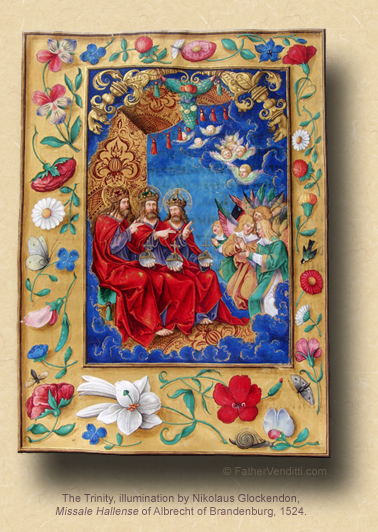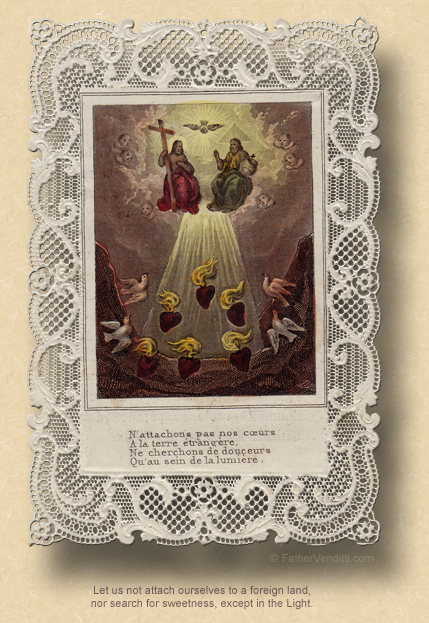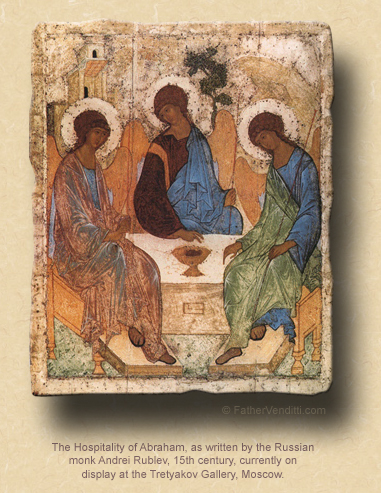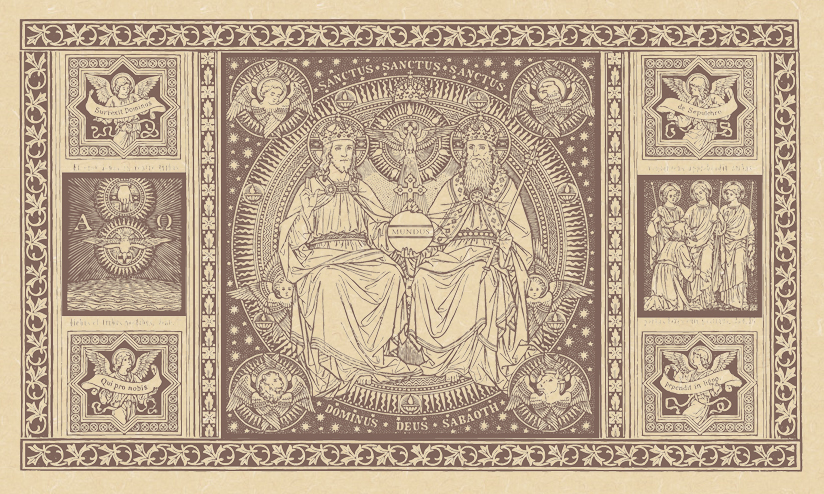Seeing Three, He Adored One.
The First Sunday after Pentecost: the Solemnity of the Most Holy Trinity.
Lessons from the secondary dominica, according to the ordinary form of the Roman Rite:
• Deuteronomy 4: 32-34, 39-40.
• Psalm 33: 4-6, 9, 18-20, 22.
• Romans 8: 14-17.
• Matthew 28: 16-20.
The First Sunday after Pentecost: the First Class Feast of the Most Holy Trinity.
Lessons from the dominica, according to the extraordinary form of the Roman Rite:
• Romans 11: 33-36.
• [Gradual] Daniel 3: 55-56.
• Matthew 28: 18-20.
FatherVenditti.com
|
7:40 AM 5/30/2021 —
[Abraham] had a vision of the Lord […] in the valley of Mambre, as he sat by his tent door at noon. He looked up, and saw three men standing near him; and, at the sight, he ran from his tent door to meet them, bowing down to the earth. Lord, he said, as thou lovest me, do not pass thy servant by; let me fetch a drop of water, so that you can wash your feet and rest in the shade. I will bring a mouthful of food, too, so that you can refresh yourselves before you go on further; you have not come this way for nothing. And when they had agreed to what he proposed, Abraham hastened into the tent to find Sara. Quick, he said, knead three measures of flour, and make girdle-cakes. Meanwhile, he ran to the byre, and brought in a calf, tender and well-fed, and gave it to a servant, who made haste to cook it. Then he brought out butter and milk with the calf he had cooked for them, and laid their meal ready, and stood there beside them in the shade of the trees (Genesis 18: 1-8 Knox).
 That esoteric sounding passage is from the Book of Genesis. It describes our Father in Faith, Abraham, receiving a visit from three young men, and offering to them the hospitality of his home. If you're wondering why I read it to you after having heard, along with you, the three beautiful readings presented to us by Holy Mother Church for this important feast, that's appropriate, since today is Trinity Sunday, and the Trinity is a mystery, so there's no reason why I shouldn't attempt to be mysterious, as well. That esoteric sounding passage is from the Book of Genesis. It describes our Father in Faith, Abraham, receiving a visit from three young men, and offering to them the hospitality of his home. If you're wondering why I read it to you after having heard, along with you, the three beautiful readings presented to us by Holy Mother Church for this important feast, that's appropriate, since today is Trinity Sunday, and the Trinity is a mystery, so there's no reason why I shouldn't attempt to be mysterious, as well.
There is, of course, a reason, and I'm going to ask you to bear with me as I reveal it to you slowly, in much the same way that God has revealed the mystery of the Trinity to His Church over the centuries.
The readings provided by the Mass today bear on the Blessed Trinity in rather obvious ways. Our first reading, from Deuteronomy, speaks to us of the Father existing from all eternity, the Lord of both heaven and earth, intervening directly in the history of the people He has chosen to be His own. In the second reading, the Blessed Apostle Paul tells the Christians in Rome how it was the sending of the Holy Spirit, which he calls “the Spirit of Adoption,” which makes them the sons and daughters of God. And in the Holy Gospel, our Lord, just before ascending home to His Father, reminds his disciples that He and His Father are one, that everything the Father is He is also, commanding them to baptize all the nations in the name of the Father, and of the Son, and of the Holy Spirit.
But what about this passage from Genesis? What does it have to do with the Holy Trinity? I know you don't have your Bibles in front of you, but I'm going to try and explain why this story from the Old Testament is so very important on this grace-filled day dedicated to the Blessed Trinity.
The story is a famous one: Abraham is minding his own business, sowing patches into his tent or something like that, when he's approached by three young men; and yet, the account begins with the line, “He had a vision of the Lord….”  How do these three young men constitute a vision of the Lord? In the course of their conversation, Abraham, himself, can't seem to decide if he's addressing three people or just one: sometimes he speaks to them in the plural, and sometimes in the singular. As the passage goes on, it is revealed to us that these three young men are actually angels; but, throughout the Holy Scriptures, angels, when sent by God to deliver a message, often did not speak with their own voices, but with God's. When the angel Gabriel visited the prophet Zachariah to announce that his wife, Elizabeth, would conceive a son who would become John the Baptist, he spoke with his own voice, and even said, “My name is Gabriel, and my place is in God’s presence; I have been sent to speak with thee, and to bring thee this good news” (Luke 1: 19 Knox). When the angel of the Lord appeared to the prophet Elijah, he spoke with God's voice, and spoke directly to the prophet as God, almost like hearing someone's voice through a loud speaker: what you see is the speaker, but what you hear is the voice of One you cannot see. How do these three young men constitute a vision of the Lord? In the course of their conversation, Abraham, himself, can't seem to decide if he's addressing three people or just one: sometimes he speaks to them in the plural, and sometimes in the singular. As the passage goes on, it is revealed to us that these three young men are actually angels; but, throughout the Holy Scriptures, angels, when sent by God to deliver a message, often did not speak with their own voices, but with God's. When the angel Gabriel visited the prophet Zachariah to announce that his wife, Elizabeth, would conceive a son who would become John the Baptist, he spoke with his own voice, and even said, “My name is Gabriel, and my place is in God’s presence; I have been sent to speak with thee, and to bring thee this good news” (Luke 1: 19 Knox). When the angel of the Lord appeared to the prophet Elijah, he spoke with God's voice, and spoke directly to the prophet as God, almost like hearing someone's voice through a loud speaker: what you see is the speaker, but what you hear is the voice of One you cannot see.
In this case, the message God wants to send to Abraham, next to the Annunciation made to our Blessed Mother, may be the most important message sent from Heaven to Earth: God wants to tell Abraham about the birth of his son, Isaac, and how Abraham, himself, will become the father of God's Holy People, beginning a lineage which would continue for generations, right through to the birth of Christ, Himself; and, for this message, God figures that just one angel isn't enough. He sends three, because He wants to speak to Abraham with His whole voice, or, if you prefer, with all three of His voices: the voice of the Father, the voice of the Son, and the voice of the Spirit who proceeds from them both.
Many traditional Roman Catholic churches have images of the Blessed Trinity in them, usually in some sort of magnificent stained glass window, or carved in relief over a door, or perhaps painted on the ceiling of the sanctuary, and most of them are fairly similar: they depict God the Father as an old man with a full and flowing white beard seated on His thrown in heaven; they depict God the Son as, of course, our Blessed Lord, usually seated next to Him; the Holy Spirit is typically displayed the way He manifested Himself at our Lord's baptism in the Jordan: as a dove. Eastern Christian churches, both Catholic and Orthodox, also have images of the Trinity in them, but they are very different:  it usually takes the form of a very simple icon showing three angels seated at table, being served a meal by Abraham. Sometimes it's accompanied by an inscription by Our Holy Father Augustine of Hippo who, in his great treatise on the Blessed Trinity, said of the hospitality of Abraham, “Seeing three, he adored one.” it usually takes the form of a very simple icon showing three angels seated at table, being served a meal by Abraham. Sometimes it's accompanied by an inscription by Our Holy Father Augustine of Hippo who, in his great treatise on the Blessed Trinity, said of the hospitality of Abraham, “Seeing three, he adored one.”
Trying to consider the Holy Trinity as a theological concept on this Trinity Sunday is a waste of time. Saint Augustine, in the Third Century, wrote one of the biggest books he ever wrote on the Blessed Trinity, and all he could say at the end of it was: it's a mystery. Without having the mind of God, there is no way that we can understand how He can be both one and three at the same time: how the Father can be all God, how the Son can be all God, how the Holy Spirit can be all God, and how together they are one God. I think it is more profitable for us, on this great and holy feast, not to try and reflect on the Trinity as theological dogma, but rather as a spiritual lesson. We are not God, which means that there are some things in our lives that we simply will never understand. When Abraham conversed with the three young men, he couldn't figure out if he was speaking to one or three, and didn't know until after they were gone that he had been speaking with God. But that didn't stop him from serving Him and giving what he had to give.
Like Abraham, we, too, don't often know what God may be trying to tell us through the circumstances of our lives, or even if it is God speaking to us; but that's OK. So long as we continue to serve Him, so long as we remain open to hearing His voice, so long as we remain ever docile and obedient to the movement of Divine Providence, we can be confident that we will always be pleasing to Him.

|

